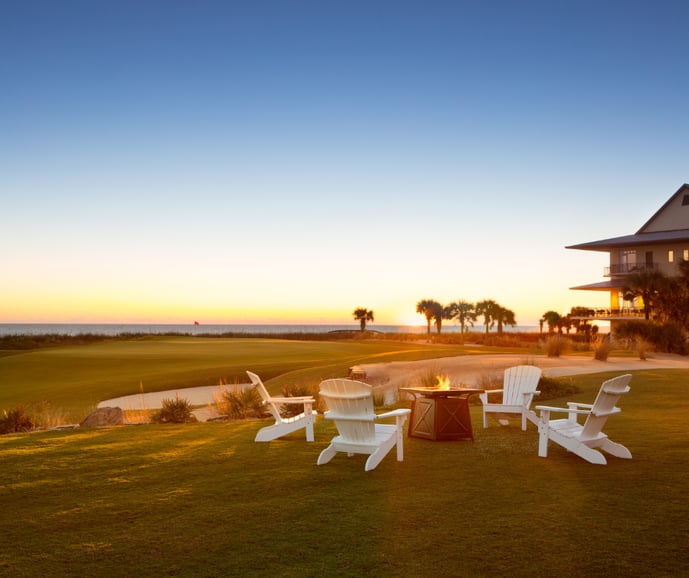The Club at Hammock Beach Blog

The Third Place: Importance of a Social Sanctuary
- May 8 2025
- Kate Batzel
In today's overly connected, screen-driven world, something essential is slipping through our fingers: authentic human connection. According to a Harvard study, 36% of Americans report feeling "seriously lonely." This isn't just a statistic — it's a concern we should keep at the forefront of our minds. Enter the third place, those magical spaces between home and work, offer a sanctuary where relationships can thrive, creativity is sparked, and communities form. As people struggle with remote work and digital fatigue, the need for safe, accessible third places has never been greater.
What are Third Places?
Third places are the informal gathering spots that sit apart from home (the "first place") and work (the "second place"). Urban sociologist Ray Oldenburg popularized the concept of third place sociology in his influential research. He described third places as the anchor of community life, building broader, more creative social interaction.
According to Oldenburg, these spaces are neutral grounds where conversation is the main activity, accessibility is everything, and “regulars” create a welcoming environment. Think of the show Cheers when Norm enters, and everyone yells his name immediately, making him feel welcome and comfortable. This can be coffee shops, parks, community centers, or even clubs like The Club at Hammock Beach.
The Importance of Third Places
Third places are more essential today than ever before. They help counter growing feelings of isolation and nurture a much-needed sense of belonging. Social interaction outside the home and workplace strengthens community ties, builds trust, and fosters emotional resilience. Experts emphasize that the correct third place offers an "essential balance" between professional life and personal well-being.
Third places do more than serve individuals; they can help communities, cities, and towns thrive. They enhance the allure of specific neighborhoods, improve social structure, and create safer, more connected communities. Areas with third places enjoy higher property values, greater community engagement, and healthier, happier residents.
Third Place vs Second Place: Key Differences
Understanding the difference between a second and a third place is the key to recognizing their unique value. A second place — the workplace — is often associated with obligations, schedules, and performance. However, third places prioritize relaxation, creativity, and social bonding.
|
Feature |
Second Place (Work) |
Third Place |
|
Purpose |
Productivity and task completion |
Connection and community |
|
Atmosphere |
Structured, hierarchical |
Informal, egalitarian |
|
Participants |
Colleagues, clients |
Friends, acquaintances, new people |
|
Feeling |
Pressure, deadlines |
Relaxation, freedom |
Second places might come with weighty roles and responsibilities, but third places are where people can leave labels and responsibility at the door and simply be themselves.
Benefits of Third Places for Wellness and Community
The benefits of third places go far beyond casual conversation or meeting new people. These community spaces are directly tied to better mental health and emotional well-being. Socializing and interacting in welcoming environments reduces feelings of loneliness, depression, and anxiety.
Engaging with a diverse group of people with similar interests helps build empathy, enhances social skills, and creates a sense of belonging. According to research on social determinants of health, meaningful social connections are as vital to long-term health as a nutritious diet or regular exercise.
Areas that actively develop and maintain third places experience greater resilience during economic hardships, natural disasters, and social unrest. Third places seem to be the social glue that binds different groups into cohesive, supportive communities.
Characteristics of a Great Third Place
Not every place where people gather qualifies as a true third place. Specific characteristics define these special spaces:
- Conversation is a Main Activity
- Accessibility and Accommodation: Easy to reach and welcoming.
- Regulars: People who are a constant in this place and set the tone for newcomers.
- Low Profile: A fun, relaxed atmosphere where people can be themselves.
- Fun Mood: Laughter and camaraderie are staples in this place.
The best third places feel like a natural extension of home and foster authentic, unforced connections.
No matter where you live, there are options for a third place. Maybe it’s where you gather to play cards, hop on the tennis court, join a pickleball team, or enjoy views from the golf course. Places like The Club at Hammock Beach have been designed to create environments where members can socialize, relax, and recharge away from the demands of daily life and find enjoyable time in a third place that genuinely feels like a home away from home.
Subscribe to our Blog

.jpg?width=2000&name=Palm%20Coast%20-%20Hammock%20Beach%20Resort%20-%20Multi-Gen%20Family%20Enjoying%20Treats%20Around%20Fire%20Pit%20with%20Musician-C%20-%202024%20(Emergent).jpg)

